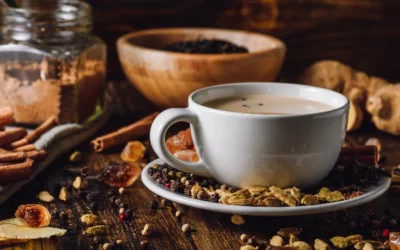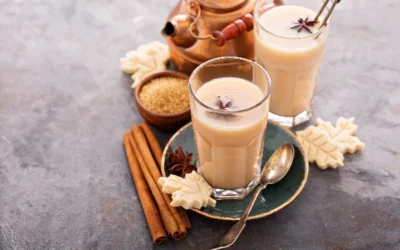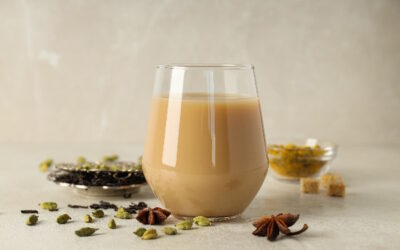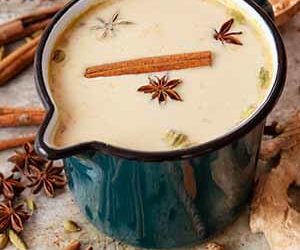Many people wonder, Does chai latte have coffee? In this article, we’ll delve into the origins of this beloved beverage, breaking down its components and variations, and uncovering whether coffee plays a role in its delightful blend. From traditional recipes steeped in Indian culture to modern twists you might find at your local café, there’s much to explore. Join me as we uncover the secrets of chai latte, its rich spices, and fascinating preparations—your next favourite drink may just be a sip away!
Table of Content
- Does chai latte have coffee?
- What is a chai latte?
- Does a chai latte contain coffee?
- What are the key spices used in a chai latte?
- How is a chai latte prepared?
- What is the traditional method of making a chai latte?
- How can you make a chai latte using pre-mixed blends?
- What are some common sweeteners used in chai lattes?
- What are the variations of chai latte?
- How does chai latte compare to other beverages?
- What are the health benefits of drinking chai latte?
- How can you customise your chai latte?
- Conclusion
Does chai latte have coffee?
No, chai latte does not contain coffee. Instead, it is a blend of spiced tea and milk. It is often confused with coffee-based lattes because it shares the same ‘latte’ component, which means ‘milk’ in Italian.
Despite not having coffee, chai lattes offer a similar comforting and creamy experience due to their rich blend of spices and milk. The unique composition of a chai latte makes it a popular alternative for those who prefer not to consume coffee.
What is a chai latte?
A chai latte is a tea-based beverage that is traditionally made by brewing black tea with a mix of aromatic spices and herbs. This spiced tea is then combined with steamed milk to create a creamy, flavourful drink. Originating in India, chai has become a global sensation with many modern adaptations.
What are the main ingredients in a traditional chai latte?
A traditional chai latte comprises several key ingredients that give it its distinctive taste:
- Black tea: Typically Assam or Darjeeling
- Spices: Commonly include cardamom, cinnamon, cloves, ginger, and black pepper
- Sweetener: Sugar, honey, or other sweeteners enhance the flavour
- Milk: Steamed milk, usually whole milk or alternatives like almond or soy
- Water: For brewing the tea and spices
These ingredients combine to create a warm and soothing beverage with layers of rich, spicy flavours.
How did chai latte originate?
Chai has its origins in India, where it is simply known as “chai” or “masala chai.” The word “chai” means tea in Hindi, and “masala” refers to the blend of spices used. Historically, masala chai was crafted from black tea, which was first cultivated in India during the colonial period.
- Indian heritage: Chai is deeply rooted in Indian culture and is consumed daily by millions
- Traditional preparation: In India, chai is often made by boiling tea leaves and spices in water and milk
- Colonial influence: The British popularised the tea-drinking habit in India during their rule
- Street vendors: Chai wallahs, or tea vendors, are a common sight in India, serving freshly brewed chai to locals and visitors alike
This traditional drink has now evolved into the chai latte, enjoyed worldwide.
How has chai latte evolved over time?
Chai latte has undergone significant transformations as it journeyed from India to the rest of the world. The traditional masala chai was adapted to suit various tastes and preferences, leading to modern versions that are served in coffee shops and homes alike.
- Western influence: Baristas began steaming the milk, creating the frothy texture seen in cafes
- Sweet variations: Flavours like vanilla, caramel, and pumpkin spice became popular
- Milk alternatives: Dairy-free options like almond, oat, and soy milks cater to different dietary needs
- Convenience products: Instant chai powders and chai concentrate make preparation easier
- Global popularity: Chai lattes are now a staple in many cafes around the world, each with their variations
This evolution has made chai latte accessible and customisable, appealing to a wider audience.
The history of chai dates back to an ancient Indian court, where a king’s Ayurvedic doctor experimented with a combination of spices to create a medicinal beverage. This early version of chai had no tea or sweeteners. Instead, it was a spiced, herbal concoction that evolved over centuries. Eventually, the British influence in India introduced black tea to the mix, leading to the chai we know today.
I remember my first encounter with a chai latte at a local café. Even though I was a pure tea lover, the barista’s description intrigued me. The steaming cup was a revelation; warm spices swirled with sweet milk offered a comforting blend I hadn’t anticipated. It quickly became my go-to on cold mornings. The experience was not just about the drink itself, but the warmth and culture it represented.
Does a chai latte contain coffee?
A traditional chai latte does not include coffee. Instead, it consists of brewed black tea blended with spices such as cinnamon, cardamom, and ginger, steamed milk, and a sweetener like honey or sugar. However, modern variations have evolved, often blending coffee into the mix to suit changing tastes.
The core of the debate around chai lattes and coffee inclusion centres on these evolving recipes. Understanding this requires a closer look at the different types of chai lattes and their ingredients. Below is a table outlining traditional and contemporary chai latte ingredients, and noting whether coffee is part of the mix.
| Type of Chai Latte | Ingredients | Coffee Inclusion |
|---|---|---|
| Traditional Chai Latte | Black tea, cinnamon, cardamom, cloves, ginger, milk, sweetener | No |
| Masala Chai Latte | Black tea, black pepper, coriander, star anise, ginger, milk, sugar | No |
| Dirty Chai Latte | Black tea, spices (varied), espresso, milk, sweetener | Yes |
| Vegan Chai Latte | Black tea, spices (varied), plant-based milk (almond, soy, etc.), sweetener | No |
| Iced Chai Latte | Black tea, spices (varied), cold milk, ice, sweetener | No |
| Chai Latte with Rooibos Tea | Rooibos tea, spices (varied), milk, sweetener | No |
| Mocha Chai Latte | Black tea, spices (varied), chocolate syrup, milk, espresso | Yes |
| Green Tea Chai Latte | Green tea, spices (varied), milk, sweetener | No |
This table helps you navigate the different chai latte options. Notice that traditional and many modern variations do not include coffee. However, variations like the Dirty Chai Latte and Mocha Chai Latte do blend in the boldness of coffee.
How can you make a traditional chai latte at home?
Making a traditional chai latte at home is quite simple with the right ingredients. It allows you to control the strength and sweetness to match your taste. Here’s a basic guide on how to do it:
- Ingredients:
- Black tea leaves
- Whole spices: cinnamon sticks, cardamom pods, cloves, ginger
- Milk (dairy or plant-based)
- Sweetener (honey, sugar, or any preferred sweetener)
- Steps:
- Boil Water: Start with boiling water in a saucepan and add tea leaves.
- Add Spices: Toss in the whole spices and let it simmer for about 5-10 minutes.
- Simmer: Allow it to sit so the flavours meld together.
- Add Milk: Pour in the milk and let it warm up without reaching a boil.
- Sweeten: Add your choice of sweetener and mix until dissolved.
- Strain and Serve: Strain the mixture into a mug and enjoy.
Mastering a homemade chai latte can be a great way to enjoy this delightful beverage without needing to visit a café.
What are popular variations of chai latte?
Chai lattes offer a broad canvas for experimentation. Besides the classic recipe, there are several popular variations to explore.
- Dirty Chai Latte: Adds a shot of espresso to the traditional chai, giving a caffeine boost and a deeper flavour.
- Masala Chai Latte: Uses a more robust spice mix that includes black pepper and coriander.
- Vegan Chai Latte: Swaps dairy milk for plant-based alternatives like almond or soy.
- Iced Chai Latte: Brewed chai tea chilled and mixed with cold milk over ice.
- Green Tea Chai Latte: Substitutes black tea with green tea for a lighter flavour.
- Mocha Chai Latte: Combines chai spices with chocolate syrup and espresso for a rich, indulgent taste.
- Rooibos Chai Latte: Uses rooibos tea, offering a caffeine-free option with a unique, mild flavour.
These variations allow you to enjoy chai latte in different moods and dietary preferences. Whether adding coffee for a Dirty Chai or keeping it vegan, the versatile nature of chai latte caters to everyone’s taste.
In the early 1900s, India saw an unprecedented spread of tea culture, thanks to British colonial influence. The Indian Tea Association promoted chai with an increased boiling-time recipe that involved black tea, spices, milk, and sugar.
This fusion was initially meant to boost tea consumption among the Indian populace but quickly transformed into a unique cultural staple that became synonymous with Indian hospitality.
I remember the first time I tried making my own chai latte. I followed my grandmother’s recipe passed down through generations. As I ground the spices, I felt a deep connection to my family’s history, imagining them doing the same.
The aroma of fresh spices and simmering tea filled my kitchen and took me back to my childhood, sitting in my grandmother’s kitchen, waiting for that warm, comforting cuppa. Today, making chai latte at home is more than a ritual; it’s a way of honouring my heritage.
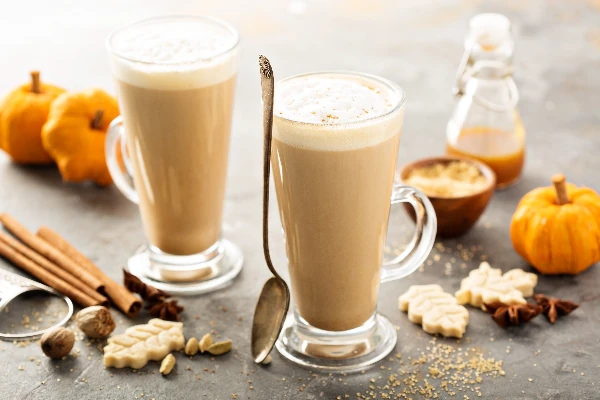
What are the key spices used in a chai latte?
Magic potions, ancient elixirs, and your grandma’s secret soup recipe all have one thing in common – spices. Similarly, chai latte’s signature charm lies in its handpicked array of spices. Let’s break down the usual suspects that elevate this frothy drink to legendary status.
You’ve got cinnamon, ginger, cardamom, cloves, and black pepper. Quite a line-up, isn’t it? Each of these ingredients contributes its own unique twist to the chai latte, making it a drink that’s rich, aromatic, and ever so tantalizing.
What role does cinnamon play in a chai latte?
Cinnamon waltzes into the chai latte party like it’s the belle of the ball, and for good reason. This spice adds a sweet, warming flavour along with a touch of spiciness. Whether it’s Saigon, Ceylon, or the good ol’ supermarket variety, cinnamon brings an unmistakable sweetness and fragrant aroma that forms the base of your chai latte experience.
- Aroma: Sweet, woody, and warm scent
- Flavour: Adds sweetness with a bit of spicy zest
- Types: Saigon, Ceylon, and standard cinnamon
- Texture: Fine powder or ground
- Colour: Generally brown or reddish-brown
Cinnamon does more than just jazz up your latte cup; it also packs an impressive nutritional punch. From stabilising blood sugar to acting like a tiny antioxidant grenade, this spice is nothing short of a superstar. So, the next time you sip on that delicious chai latte, give a nod to the cinnamon making it all possible.
How does ginger contribute to the flavour profile?
Ginger struts in like that friend who always has the best stories – bold, fiery, and impossible to ignore. This root, with its zingy and refreshing qualities, adds a touch of spice that cuts through the creamy sweetness of milk and sugar.
- Aroma: Sharp, fresh, with a hint of citrus
- Flavour: Spicy, pungent, with a tangy kick
- Form: Fresh, ground, or dried
- Colour: Yellowish to light brown
It’s like that energetic track in your playlist that never fails to pump you up. Ginger’s peppery zest balances the chai latte’s sweetness, making the drink electrifying and memorable. Plus, it boasts some pretty awesome digestive benefits – like that micro manager of your gut health, constantly keeping things in check.
Are there any health benefits associated with these spices?
You bet your sweet mug of chai, there are! These spices don’t just taste heavenly; they’re also like a mini physician, tending to various aspects of your health. Let’s spill the beans – or rather, the spices – on some health perks.
- Cinnamon: Stabilises blood sugar, chocks full of antioxidants, and could improve heart health.
- Ginger: Aids digestion, eases nausea, and has anti-inflammatory properties.
- Cardamom: Aids in digestion, helps detoxify the body, and improves oral health.
- Cloves: Packed with antioxidants, good for toothache relief, and supports liver health.
- Black Pepper: Enhances nutrient absorption, improves digestion, and has anti-inflammatory effects.
These spices aren’t just flavour enhancers – they’re like little health nuts providing a range of benefits while doing a flavour jig in your chai latte. Combining these spices in a single cup is like having a wellness team on standby, each bringing its A-game to ensure your drink is both delicious and nutritious.
Let’s end with a slice of history. During the British colonial era in India, tea was just tea until the locals, forever in love with their spices, tossed cinnamon, ginger, and cardamom into the boiling mix.
What started as an experiment evolved into the beloved chai. Even the British couldn’t resist; they adopted it and took it back home, creating the phenomenon of the chai latte we cherish today. So, next time you’re sipping your spicy brew, remember – it’s got a history as rich as its flavour.
How is a chai latte prepared?
Alright, caffeine enthusiasts and chai fans, let’s dive right into the aromatic wonders of chai latte preparation. We’ll navigate through brewing black tea, adding spices, steaming milk, and also touch on the timesaving joy of pre-mixed blends. Get ready for a journey that smells amazing.
So, first things first, a chai latte is a delicious concoction blending spicy and sweet flavours, typically without a hint of coffee. Think of it as your perfect afternoon buddy that keeps you calm while tantalising your taste buds. Let’s break it down.
What is the traditional method of making a chai latte?
Traditionally, making a chai latte is a delightful ritual that starts with brewing black tea, the base of this lovely beverage. You can use loose leaves or tea bags, but either way, you’re in for a treat. Here’s how it unfolds:
- Brewing Black Tea: Heat water until it’s just about to boil. Then, add your black tea leaves or bags and let them steep for about 5-10 minutes. The longer it steeps, the stronger it gets.
- Adding Spices: Here comes the magic – cardamom, cinnamon, ginger, cloves, and black peppercorns jump into the mix. You can crush these to release more flavour and add them to your brewing tea.
- Steaming Milk: While your tea is brewing, steam your choice of milk. Traditionalists often go for whole milk, but almond, soy, or oat milk are excellent options if you’re feeling fancy or dairy-averse.
- Sweetening the Deal: Finally, add sweeteners if that’s your thing. Sugar, honey, or maple syrup are top contenders.
Consider a traditional chai latte to be the kind of experience you can wrap yourself in like a warm blanket on a cool day.
How can you make a chai latte using pre-mixed blends?
Ah, the hustle life! If you’re too busy to steep, steam, and stir, pre-mixed chai latte blends are here to rescue you. And guess what, they still give you that rich, spicy, comforting concoction with less hassle.
Blends usually contain:
- Instant Black Tea Powder: Because nobody’s got time to brew.
- Spice Mix: A combo of ground cardamom, cinnamon, ginger, and often, cloves or star anise.
- Milk Powder: Saves you the trouble of steaming your milk.
- Sweeteners: Pre-added sugars to make it palatable.
Using pre-mixed blends is simple:
- Step 1: Heat water or milk. Your choice.
- Step 2: Add the pre-mixed chai powder.
- Step 3: Stir well.
- Step 4: Enjoy while pretending you spent hours making it.
It’s like getting a gourmet meal from a food truck – quick and satisfying.
What are some common sweeteners used in chai lattes?
The key to a superb chai latte is the balance between spice and sweetness. Whether you’re a sugar junkie or prefer natural alternatives, there are sweeteners aplenty to choose from.
- Sugar: Classic granulated white sugar or brown sugar. It’s straightforward.
- Honey: Adds a touch of floral sweetness.
- Maple Syrup: Perfect for a hint of that autumn vibe.
- Agave Syrup: A lower-glycaemic alternative, keeping things sweet without the sugar spike.
- Stevia: A plant-based, calorie-free sweetener.
Each sweetener brings its unique charm to the chai latte, adding complexity or simplicity depending on your pick.
To flavour it up even more, sometimes people add flavoured syrups – vanilla, caramel, and even lavender for the adventurous souls.
In the bustling streets of ancient India, where chai originated, tea vendors known as “chai wallahs” perfected the tradition of making chai. Legend has it that in the British colonial era, the British influence popularised tea across the Indian subcontinent.
Delhi’s Connaught Place had one particularly famous chai wallah who would draw daily crowds for his elaborate preparation rituals and secret spice blend. His chai became so legendary that even British officers would sneak from their stations just to have a sip. Little did they know, his ‘secret’ blend included the unique addition of star anise – a twist which gave his brew a mystique that sparked tea-time diplomacy.
Enjoy your playfully spiced journey into chai lattes, and remember, it’s all about the experience.
What are the variations of chai latte?
Chai latte–it’s like hugging your soul with a mug of spiced, milky goodness, but did you know it’s got more variations than a cat has lives? Seriously, you could sip a different chai latte every day and still not get through them all in a month. Let’s dive into these deliciously varied concoctions, shall we?
First up, there’s the iced chai latte. Perfect for when you want your spicy sip but the weather’s hot enough to fry an egg on the pavement. It’s just like your regular chai, but icy cold and refreshing.
Next, we’ve got the dirty chai latte. No, it’s not a latte with a side of gossip; it’s your chai jacked up with a shot of espresso for when you need that extra kick. Think hybrid between your favourite cup of tea and that early morning espresso.
Then, we have the vegan chai latte. This one’s for the animal-loving, environmentally conscious peeps. It’s as creamy and spicy as the original but swaps out the dairy for plant-based milk like almond, oat, or soy.
Don’t care for caffeine? Say hello to the decaf chai latte. All the spice and none of the jitters. And lastly, let’s not forget the flavoured chai lattes. Imagine chai with a hint of vanilla, caramel or mocha. Now, that’s what I call variety!
What is a dirty chai latte?
Think of the dirty chai latte as the rebellious cousin of the classic chai latte. It’s got attitude. It’s essentially a traditional chai latte that’s been spiked with a shot (or two, if you’re feeling wild) of espresso. The combination is a wicked mix of the spicy chai flavour and the boldness of coffee.
- Espresso shot added to chai latte.
- Combines the creamy, spicy sweetness of chai with the strong, bitter hit of espresso.
- Often made with either single or double shot espresso.
- Can be served hot or iced.
- Popular among those who can’t decide between coffee and tea.
You sip it, and it’s like getting a warm hug and a slap on the back simultaneously. Perfect for when you need a bit more oomph to kick start your day.
How can you make a vegan chai latte?
Going vegan doesn’t mean you have to miss out on yummy drinks, and the vegan chai latte is here to prove that. Making one is as simple as pie (vegan pie, of course).
- Use plant-based milk like almond, soy, oat, or coconut.
- Brew strong chai tea, with your preferred level of spice.
- Sweeten it with maple syrup, agave nectar, or another vegan sweetener.
- Froth the plant-based milk if you’re fancy—yes, you can still get that foam without cow’s milk.
- Mix the tea and milk together.
There you have it, your creamy, spicy, compassionately-made vegan chai. Whether you prefer it piping hot or chilled, it’s a treat that’s kind to both yourself and the planet.
What are some popular flavours for chai lattes?
Sick of the same old same old? Go crazy and try out some flavoured chai lattes. These additions can take your chai game from meh to marvellous.
- Vanilla chai latte for those who prefer a touch of sweetness.
- Caramel chai latte for caramel lovers craving that burnt sugar flavour.
- Mocha chai latte for a perfect blend of chocolatey and spicy.
- Pumpkin spice chai latte – because who doesn’t want to be a part of the pumpkin spice hype?
- Rose chai latte for a floral twist that smells as good as it tastes.
Getting creative with your chai can turn an everyday drink into something extraordinary. It’s all about mixing and matching until you find your perfect blend.
In 18th century India, chai was more than just a tasty beverage; it was practically a medicinal potion. During British colonisation, the East India Company introduced black tea production to India, primarily for export. However, locals began blending the tea with local spices, milk, and sugar – voila, the first chai! Fast forward to today, and chai lattes have taken the world by storm with endless creative spins on this age-old drink. So next time you savour your chai latte, remember, you’re enjoying a rich blend of history and modern flair.
How does chai latte compare to other beverages?
Alright, my caffeine-loving friend, let’s dive into the wonderful world of beverages and how our star of the show, the chai latte, stacks up against the competition. Let’s pit it against the usual suspects: traditional latte, cappuccino, matcha latte, hot chocolate, and herbal tea.
So, you’re probably wondering how these drinks square up. Worry not, we’ve got it all mapped out in a straight-talking, no-fluff kind of way.
How does a chai latte differ from a traditional latte?
First off, let’s talk taste and ingredients. A traditional latte is an espresso-based drink made with steamed milk and a bit of foam. Sounds simple, right? Well, that’s because it is.
On the other hand, a chai latte is a spicy, flavour-packed concoction. It’s got black tea, various spices (think cinnamon, cardamom, cloves), milk, and often a sweetener.
- Latte has the bold, robust kick of coffee because of the espresso.
- Chai latte is all about the rich, aromatic spices and the soothing mellowness of black tea.
- Latte is your go-to if you’re looking for that straight-up caffeine boost.
- Chai latte provides a gentler pick-me-up, thanks to the tea’s lower caffeine content.
- Traditional latte includes minimal ingredients: espresso and milk.
- Chai latte involves a blend of spices, making it more complex.
Now, both drinks are warming, but the experiences are distinct. Consider a latte like a dependable, slightly intense friend, whereas a chai latte is the exotic, comforting one.
What are the similarities between chai latte and matcha latte?
Okay, this is where things get fun. Both chai and matcha lattes are loved by those chasing that earthy feel and healthier vibe.
- Both are tea-based drinks, which means they don’t have coffee’s full-throttle jolt.
- Each features a blend of milk and some form of sweetener, creating that creamy texture.
- Chai and matcha are packed with antioxidants, bringing in the health benefits.
- They are versatile and can be enjoyed hot or iced.
- Both teas are a splendid alternative for those cutting down on coffee.
However, while chai walks on the sweeter and spicier side, matcha is all about that fine, green tea leaf powder, offering a grassy, umami-rich flavour. So, it’s kind of like comparing spice markets to a Zen garden.
Is chai latte a healthier option compared to hot chocolate?
Now comes the soul-comforting showdown. When you want a cosy drink, you might reach for hot chocolate. But hold on, is chai latte a healthier bet?
- Chai latte typically contains less sugar, unless you’re heavy-handed with the sweetener.
- Both drinks can be rich, but hot chocolate has those extra calories from the chocolate.
- Chai, thanks to the spices and tea, brings in antioxidants and can aid digestion.
- Hot chocolate’s flavonoids also offer some benefits, but the sugary overload can overshadow them.
- A chai latte, in its traditional form, is naturally lower in fat.
In musical terms, hot chocolate is like that indulgent ballad that you shouldn’t put on repeat too often. Chai latte, meanwhile, is like a catchy tune that’s both enjoyable and a tad more sustainable for everyday listening.
So there you go. You’ve got the facts, the flavours, and a clear idea of how our chai latte compares with the rest. Now, speaking of options, did you know that the history books reveal fascinating insights into favourite beverages?
Way back in the 1600s, when the British East India Company set up shop in India, they were all about the black tea trade. Little did they know, the locals added spices and milk, giving birth to what we now savour as chai. The colonists just saw it as tea. So, thanks to some enterprising souls, we now enjoy the rich, spiced delight known as the chai latte. History sure knows how to brew a good story, right?
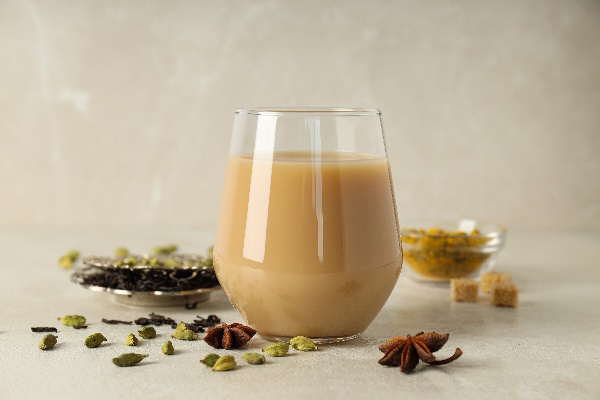
What are the health benefits of drinking chai latte?
So, you’re wondering if that cosy cup of chai latte is just a treat for the taste buds or if it packs a punch in the health department too. Well, spoiler alert: it’s not just your taste buds that benefit! Chai latte, a wondrous blend of spices and tea, isn’t just an aromatic hug in a mug. It’s chock full of health benefits that can make you feel like you’ve got a personal wellness guru in your cup. Let’s dive into the good stuff.
First off, what makes chai latte a mini health booster? Its secret weapon: spices! We’re talking about ginger, cardamom, cinnamon, cloves, and black pepper, all dancing in your cup like a health-benefit disco. Add in some black tea, and you’ve got a concoction that’s much more than a delicious drink.
What antioxidants are found in chai latte?
Antioxidants are like the bouncers of your body’s nightclub, keeping the riff-raff out. And guess what? Chai latte is overflowing with them. Black tea, the backbone of chai, is bursting with these protective compounds.
- Polyphenols: These babies are heavy hitters when it comes to fighting off free radicals (those nasty little molecules that can cause damage to your cells). Think of polyphenols as the unsung heroes of your immune system.
- Catechins: Found in black tea, they help boost fat burning and improve digestion. Who knew your morning cuppa could be your personal trainer?
- Flavonoids: These are the same antioxidants found in red wine and dark chocolate. They support heart health and can lower your bad cholesterol.
- Quercetin: A potent anti-inflammatory and antiviral, this one’s like having a ninja on your side.
So yeah, your chai latte is kind of like a superhero in disguise, helping your body defend against daily wear and tear.
How can chai latte support digestive health?
No one likes the feeling of a rock concert going on in their stomach, right? Chai latte, with its magical mix of spices, can bring some much-needed harmony to your gut.
- Ginger: Known to be stellar for nausea and morning sickness; ginger is the digestive system’s best mate.
- Cardamom: This little pod of goodness is fantastic for fighting bloating and heartburn. It’s like a soothing lullaby for your digestive tract.
- Black pepper: It can stimulate the stomach to produce hydrochloric acid, which is essential for digestion.
But it’s not just the spices doing the heavy lifting here. Black tea itself can help with digestion by promoting the growth of good bacteria in your gut. So, next time you’re feeling a bit off, maybe skip the chalky tablets and reach for a chai latte instead.
Are there any mental health benefits associated with chai latte?
Life’s a bit of a rollercoaster, isn’t it? Who wouldn’t want a bit of mental clarity and calmness while enjoying a flavour-packed treat? Chai latte can be your mental health buddy in more ways than one.
- Cinnamon: Contains cinnamaldehyde and can help boost brain function. It’s like a little kickstarter for your cognitive powers.
- Black tea: Provides a controlled amount of caffeine that offers alertness without the jitters. No more feeling like a squirrel on caffeine pills.
- Cloves: Known to have eugenol, which can reduce stress hormones in the body.
When you sip a chai latte, you’re not just enjoying its rich, complex flavour. You’re also giving your brain a little holiday from stress. Like a spa day, but cheaper and much easier to fit into your schedule.
Back in the ancient times of the… well, not so ancient, but the 19th century, Indian royalty swore by a version of chai called “masala chai” as a cure-all potion. It’s said that a Maharaja would serve it to his warriors before battle for its energising properties and its benefits in keeping their guts happy and warriors’ minds alert. Clearly, this royal tradition has trickled down, offering us mere mortals a taste of its age-old magic. Drink up!
How can you customise your chai latte?
So, you’ve got your warm, spicy chai latte in hand, and you’re loving it. But wait, it could be even better. Yes, that’s right – even the best can be made better. Customising your chai latte isn’t rocket science; it’s pure fun. Let’s go on a delightful quest of turning your average chai latte into a sublime experience.
Sure, you’ve got the classic chai blend that typically combines black tea with spices such as cardamom, cinnamon, ginger, cloves, and black pepper. But, that’s just the beginning, the tip of the chai iceberg. You can tweak everything – milk, sweeteners, spices, temperature, and even add some crazy flavours to make your cup sing.
What are some non-dairy milk options for chai latte?
Not everyone’s stomach is up for a dairy showdown. Whether you’ve got lactose intolerance, a vegan lifestyle, or just a moo-milk aversion, there’s a world of non-dairy options. Here are the top contenders:
- Almond Milk: Light, subtly nutty, and blends beautifully with spices.
- Oat Milk: Creamy, slightly sweet, and gives a foamy head that’s all you barista wannabes crave.
- Coconut Milk: Rich, tropical flavour that takes your tastebuds on vacation.
- Soy Milk: The OG of non-dairy – smooth, creamy, and a solid all-rounder.
- Cashew Milk: Velvety and rich; it’s like your chai is wearing a velvet jacket.
These alternatives ensure your chai latte’s smooth, creamy goodness without the dairy drama.
How can you adjust the spice level in a chai latte?
Maybe you’re Ginger Spice, maybe you’re Baby Spice; either way, you can crank up or dial down the spice level to match your taste. Here’s how you become the Spice Master:
- Add Extra Spices: Amp up the cinnamon, pop in more cardamom, or unleash a bit more ginger.
- Reduce Spices: Go easy on those that kick hard, perhaps the black pepper or cloves.
- Pre-mixed Spice Blends: There are blends out there with varying heat levels – pick your poison.
- Infused Syrups: A simple way to tweak spice flavour without hassle.
The spice level is your playground. Tweak it till it hits that Goldilocks zone – just right.
What are some unique flavourings to add to a chai latte?
Ready to go off the beaten path? Let’s throw some curveballs into your chai. These quirky additions will make your tastebuds swoon:
- Vanilla Extract: A drop transforms your cup into a creamy paradise.
- Maple Syrup: Adds sweetness with a woody twist.
- Lavender: A sprinkle and you’re in a floral fantasy.
- Pumpkin Puree: Seasonal and sensational. Hello, autumn!
- Peppermint: Turn that chai into a winter wonderland experience.
These unique flavourings can make your chai latte stand out from the ordinary.
In the 1940s, during the British colonial period in India, chai was more of a street-side affair, enjoyed by millions across the subcontinent. The beverage has been around for thousands of years, with traders from China, Persia, and beyond introducing different spices.
But it wasn’t until someone got the bright idea to blend these gorgeous spices with milk and sugar that the beloved chai latte truly came into being. It’s fascinating how this drink, initially a humble roadside staple, has now evolved into the globally adored concoction, topped with frothy milk in trendy cafes.
So, next time you take a sip, remember you hold a piece of history in your hand, one that can be customised in a myriad of ways to suit your every whim. Cheers to that!
Conclusion
As I reflect on the intricate world of chai lattes, it’s clear that this beloved beverage offers so much more than meets the eye. From its rich Indian roots, steeped in traditions of spiced tea, to the modern adaptations that have captured the hearts of beverage enthusiasts worldwide, the chai latte is a beautiful fusion of flavours and aromas. We’ve explored its foundational components — black tea, aromatic spices like ginger and cardamom, and the comforting embrace of steamed milk — all contributing to its signature profile.
The question of whether a chai latte contains coffee may seem straightforward, yet it unveils a landscape of variations that cater to diverse tastes and dietary needs. Whether it’s a traditional chai latte brewed to perfection or a contemporary dirty chai with a caffeine punch, each iteration tells a story. Understanding these subtleties not only enriches our appreciation of this drink but also opens up discussions about the evolving nature of culinary traditions.
Beyond enjoyment, the health benefits of chai lattes, from their antioxidant properties to their digestive support, highlight the drink as a thoughtful choice for those seeking both pleasure and well-being. As we customise our chai lattes—exploring different milks, sweeteners, and spices—we engage in a personal journey of flavour that reflects our individual preferences and creativity.
So, what comes next in our exploration of chai lattes? For those intrigued, I encourage you to venture into your own chai crafting. Experiment with spices and milks to discover your ideal blend or try a vegan or decaf variant for a wholly different experience. The beauty of the chai latte is that it invites us to be curious and innovative.
In closing, I’m reminded of the words of a wise poet: “The journey of a thousand miles begins with a single step.” With every cup of chai latte we brew, let us take steps towards not only enjoying our beverages but also appreciating the cultural depth and personal connection they can foster. What will your next chai creation be?


